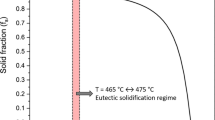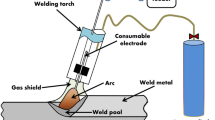Abstract
In this work, mechanical properties and fracture toughness of as-received and solution-treated aluminum alloy 5754 (AA 5754) are experimentally evaluated. Solution heat treatment of the alloy is performed at 530 °C for 2 h, and then, quenching is done in water. Yield strength, ultimate tensile strength, impact toughness, hardness, fatigue life, brittle fracture toughness \((K_{\text{Ic}} )\) and ductile fracture toughness \((J_{\text{Ic}} )\) are evaluated for as-received and solution-treated alloy. Extended finite element method has been used for the simulation of tensile and fracture behavior of material. Heaviside function and asymptotic crack tip enrichment functions are used for modelling of the crack in the geometry. Ramberg-Osgood material model coupled with fracture energy is used to simulate the crack propagation. Fracture surfaces obtained from various mechanical tests are characterized by scanning electron microscopy.



























Similar content being viewed by others
References
J.R. Davis & Associates and ASM International, Handbook Committee. Aluminum and Aluminum Alloys, ASM International, Russell, 1993
H.E. Boyer, Quenching and Distortion Control, ASM International, Metals Park, OH, 1998
K. Chandra Sekhar, R. Narayanasamy, and K. Velmanirajan, Experimental Investigations on Microstructure and Formability of Cryorolled AA 5052 Sheets, Mater. Des., 2014, 53, p 1064–1070
Y. Lee, D. Shin, K. Park, and W. Nam, Effect of Annealing Temperature on Microstructures and Mechanical Properties of a 5083 Al Alloy Deformed at Cryogenic Temperature, Scripta Mater., 2004, 51, p 355–359
D. Singh, P.N. Rao, and R. Jayaganthan, Effect of Deformation Temperature on Mechanical Properties of Ultrafine Grained Al–Mg Alloys Processed by Rolling, Mater. Des., 2013, 50, p 646–655
K.S.V.B.R. Krishna, K. Chandra Sekhar, R. Tejas, N. Naga Krishna, K. Sivaprasad, R. Narayanasamy, and K. Venkateswarlu, Effect of Cryorolling on the Mechanical Properties of AA5083 Alloy and the Portevin-Le Chatelier Phenomenon, Mater. Des., 2015, 67, p 107–117
K. Gotoh, K. Murakami, and Y. Noda, Fatigue Crack Growth Behaviour of A5083 Series Aluminium Alloys and Their Welded Joints, J. Mar. Sci. Technol., 2011, 16, p 343–353
T. Zhao, J. Zhang, and Y. Jiang, A Study of Fatigue Crack Growth of 7075-T651 Aluminum Alloy, Int. J. Fatigue, 2008, 30, p 1169–1180
P. Pao, H. Jones, S. Cheng, and C. Feng, Fatigue Crack Propagation in Ultrafine Grained Al–Mg Alloy, Int. J. Fatigue, 2005, 27, p 1164–1169
Z. Jin and P.K. Mallick, Effect of Cold Work on the Tensile and Fatigue Performance of Aluminum Alloy 5754, J. Mater. Eng. Perform., 2006, 15, p 540–548
D. Singh, P. Rao, and R. Jayaganthan, Microstructures and Impact Toughness Behavior of Al 5083 Alloy Processed by Cryorolling and Afterwards Annealing, Int. J. Miner. Metall. Mater., 2013, 20, p 759–769
P. Das, R. Jayaganthan, T. Chowdhury, and I.V. Singh, Improvement of Fracture Toughness (K1c) of 7075 Al Alloy by Cryorolling Process, Mater. Sci. Forum, 2011, 683, p 81–94
T. Yagami, K. Manabe, and T. Miyamoto, Ductile Fracture Behavior of 5052 Aluminum Alloy Sheet Under Cyclic Plastic Deformation at Room Temperature, J. Mater. Process. Technol., 2009, 209, p 1042–1047
F. Ozturk, H. Pekel, and H. Halkaci, The Effect of Strain-Rate Sensitivity on Formability of AA 5754-O at Cold and Warm Temperatures, J. Mater. Eng. Perform., 2011, 20, p 77–81
M. Garware, G.T. Kridli, and P.K. Mallick, Tensile and Fatigue Behavior of Friction-Stir Welded Tailor-Welded Blank of Aluminum Alloy 5754, J. Mater. Eng. Perform., 2010, 19, p 1161–1171
A. Bhandakkar, R.C. Prasad, and S.M.L. Sastry, Fracture Toughness of AA2024 Aluminum Fly Ash Metal Matrix Composites, Int. J. Comput. Mater., 2014, 4, p 108–124
Y. Jia and Y. Bai, Ductile Fracture Prediction for Metal Sheets Using All-Strain-Based Anisotropic eMMC Model, Int. J. Mech. Sci., 2016, 115, p 516–531
H. Li, M. Fu, J. Lu, and H. Yang, Ductile Fracture: Experiments and Computations, Int. J. Plast, 2011, 27, p 147–180
C. Zhang, L. Leotoing, D. Guines, and E. Ragneau, Experimental and Numerical Study on Effect of Forming Rate on AA5086 Sheet Formability, Mater. Sci. Eng. A, 2010, 527, p 967–972
T. Belytschko and T. Black, Elastic Crack Growth in Finite Elements with Minimal Remeshing, Int. J. Numer. Methods Eng., 1999, 45, p 601–620
N. Moës and T. Belytschko, Extended Finite Element Method for Cohesive Crack Growth, Eng. Fract. Mech., 2002, 69, p 813–833
N. Sukumar, N. Moës, and B. Moran, Extended Finite Element Method for Three-Dimensional Crack Modelling, Int. J. Numer. Methods Eng., 2000, 48, p 1549–1570
E. Giner, N. Sukumar, J. Tarancon, and F. Fuenmayor, An Abaqus Implementation of the Extended Finite Element Method, Eng. Fract. Mech., 2009, 76, p 347–368
P. Das, I.V. Singh, and R. Jayaganthan, An Experimental Evaluation of Material Properties and Fracture Simulation of Cryorolled 7075 Al Alloy, J. Mater. Eng. Perform., 2012, 21, p 1167–1181
ASTM Standard E8/E8 M, 2009, Standard Test Methods for Tension Testing of Metallic Materials, ASTM International, West Conshohocken PA, 2009
ASTM Standard E23, 2007, Standard Test Methods for Notched Bar Impact Testing of Metallic Materials, ASTM International, West Conshohocken, PA, 2007
ASTM Standard E92, 2007, Standard Test Methods for Vickers Hardness and Knoop Hardness of Metallic Materials, ASTM International, West Conshohocken, PA, 2009
ASTM Standard E399-12, Standard Test Method for Linear-Elastic Plane-Strain Fracture Toughness K 1C of Metallic Material, ASTM International, West Conshohocken PA, 2012
G.A. Clarke, W.R. Andrews, P.C. Paris and D.W. Schmidt, Single specimen tests for JIC determination, Mechanisms of Crack Growth, ASTM STP 590, American Society for Testing and Materials, 1976, p 27–42
J.W. Hutchinson and P.C. Paris, Stability Analysis of J-controlled Crack Growth, Elastic–Plastic Fracture, ASTM STP 668, American Society for Testing and Materials, 1979, p 37–64
J.R. Rice, A Path Independent Integral and the Approximate Analysis of Strain Concentration by Notches and Cracks, J. Appl. Mech., 1968, 35, p 379–386
ASTM Standard E1820-15, Standard Test Method for Measurement of Fracture Toughness, ASTM International, West Conshohocken, PA, 2015
H. Pathak, A. Singh, I. Singh, and S. Yadav, A Simple and Efficient XFEM Approach for 3-D Cracks Simulations, Int. J. Fract., 2013, 181, p 189–208
W. Ramberg, and W.R.W. Osgood, Description of Stress-strain Curves by Three Parameters. Natl. Advis. Comm. Aeronaut., Technical Note No. 902, 1943.
J. Shi, D. Chopp, J. Lua, N. Sukumar, and T. Belytschkod, Abaqus Implementation of Extended Finite Element Method Using a Level Set Representation for Three-Dimensional Fatigue Crack Growth and Life Predictions, Eng. Fract. Mech., 2010, 77, p 2840–2863
ABAQUS Analysis User’s Manual (Version 6.12), United States of America ABAQUS Inc., 2012
S. Kumar, I.V. Singh, and B.K. Mishra, XFEM Simulation of Stable Crack Growth Using J-R Curve Under Finite Strain Plasticity, Int. J. Mech. Mater. Des., 2014, 10, p 165–177
M. Tajally, Z. Huda, and H. Masjuki, A Comparative Analysis of Tensile and Impact-Toughness Behavior of Cold-Worked and Annealed 7075 Aluminum Alloy, Int. J. Impact Eng, 2010, 37, p 425–432
Z. Yang, An Energy-Based Crack Growth Criterion for Modelling Elastic–Plastic Ductile Fracture, Mech. Res. Commun., 2005, 32, p 514–524
J. Kaufman, Introduction to Aluminum Alloys and Tempers, ASM International, Russell, 2000
R. Smerd, S. Winkler, C. Salisbury, M. Worswick, D. Lloydb, and M. Finnb, High Strain Rate Tensile Testing of Automotive Aluminum Alloy Sheet, Int. J. Impact Eng, 2005, 32, p 541–560
ASTM Standard E647-15, Standard Test Method for Measurement of Fatigue Crack growth Rates, ASTM International, West Conshohocken, PA, 2015
P. Paris and F. Erdogan, A Critical Analysis of Crack Propagation Laws, J. Basic Eng., 1963, 85, p 528–533
B.F. Jogi, P.K. Brahmankar, V.S. Nanda, and R.C. Prasad, Some Studies on Fatigue Crack Growth Rate of Aluminum Alloy 6061, J. Mater. Process. Technol., 2007, 201, p 380–384
S. Cravero and C. Ruggieri, Estimation Procedure of J-resistance Curves for SE (T) Fracture Specimens Using Unloading Compliance, Eng. Fract. Mech., 2007, 74, p 2735–2757
X.K. Zhu and J.A. Joyce, Review of Fracture Toughness (G, K, J, CTOD, CTOA) Testing and Standardization, Eng. Fract. Mech., 2012, 85, p 1–46
S. Goel, N. Kumar, D. Fuloria, R. Jayaganthan, I.V. Singh, D. Srivastava, G.K. Dey, and N. Saibaba, Evaluating Fracture Toughness of Rolled Zircaloy-2 at Different Temperatures Using XFEM, J. Mater. Eng. Perform., 2016, 25, p 4046–4058
C. Menzemer and T. Srivatsan, The Quasi-Static Fracture Behavior of Aluminum Alloy 5083, Mater. Lett., 1999, 38, p 317–320
N. Alexopoulos, Impact Properties of the Aircraft Cast Aluminium Alloy Al-7Si0. 6 Mg (A357), EPJ Web Conf., 2010
Author information
Authors and Affiliations
Corresponding author
Rights and permissions
About this article
Cite this article
Kumar, P., Singh, A. Investigation of Mechanical Properties and Fracture Simulation of Solution-Treated AA 5754. J. of Materi Eng and Perform 26, 4689–4706 (2017). https://doi.org/10.1007/s11665-017-2802-8
Received:
Revised:
Published:
Issue Date:
DOI: https://doi.org/10.1007/s11665-017-2802-8




